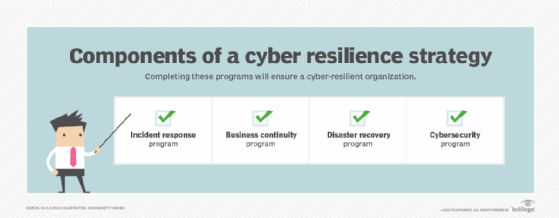
What is business continuity software?
Business continuity software is an application or suite designed to make business continuity planning/business continuity management (BCP/BCM) processes, metrics and compliance more efficient and accurate. Business continuity software helps organizations conduct business impact analyses (BIAs), create and update recovery plans, and identify gaps in BCM programs. Designed to automate the BCP/BCM process, these software tools are available either on-premises or through a software-as-a-service model.
Business continuity software is designed to help organizations run their BCM programs more efficiently and with greater agility. In addition to documenting the crucial information a business needs to remain operational despite adverse events, BCM software and systems can identify an organization's risk of exposure to internal and external threats, such as natural disasters or data breaches, and help companies respond effectively to protect the business interests of the organization. These tools can help with disaster recovery (DR), data center resiliency, business resumption and recovery, crisis management, incident management, emergency management and contingency planning.
Using business continuity software enables companies to make sure their data is accurate, comprehensive, well organized and analyzed, and up to date. These tools also provide visibility into organizations and their BCM programs, make it easier to communicate information about the programs to senior management and other stakeholders, and enable companies to respond more effectively to disruptions.
Business continuity software and compliance
Business continuity software helps ensure that programs are compliant with relevant standards and regulations. An increasing number of organizations are requiring their business partners to be compliant with business continuity standards, such as International Organization for Standardization 22301 and related specifications in the ISO 223xx series, National Fire Protection Association 1600 or those in the Federal Financial Institutions Examination Council's "Business Continuity Management" booklet.
Another standard in the ISO 223xx series, ISO 22316, provides guidance to enhance organizational resilience for any size or type of public or private organization. Although not specific to any industry or vertical market, ISO 22316 can be applied throughout the lifecycle of an organization. Resilience is defined in ISO 22316 as an organization's ability to "absorb and adapt in a changing environment."
A more recent addition to the ISO 223xx series is ISO Technical Specification (TS) 22332:2021, Security and resilience -- Business continuity management systems -- Guidelines for developing business continuity plans and procedures. It builds on ISO 22301 and ISO 22313 by providing additional guidance on developing business continuity plans. Three different types of plans are recommended:
- Strategic plan. This provides a high-level view of the procedures needed to respond to an event.
- Tactical plan. This defines how an organization responds to an event and describes how to execute the plan.
- Operational plan. This describes the response and recovery activities for individual departments, like accounting, or major functions, like manufacturing. Plans generally go into greater detail than the preceding options.
ISO 22332 goes in to depth on all aspects of a business continuity plan. Section 7 in the standard presents a basic BCP outline and then progresses through the various elements in detail.
Another relevant ISO standard is ISO/TS 22331:2018, Security and resilience -- Business continuity management systems -- Guidelines for business continuity strategy. It provides guidance on business-related strategies that should be addressed in the business continuity plan, and it can serve as a companion to the above standards.
It is important to note that only ISO 22301 is an auditable standard. Organizations can apply for certification of compliance with ISO 22301 through an authorized third-party organization. The other standards contribute and add value to ISO 22301, but none of them are needed to demonstrate compliance.
Cybersecurity compliance is another critical part of BCM. The ISO/International Electrotechnical Commission 27000 series is aimed at helping organizations secure their information assets, such as their financial information, employee details and intellectual property. Demonstration of compliance with ISO 27001 is of prime importance for cybersecurity professionals.
Alternatives to business continuity management software
Business continuity software is typically more effective for enterprise applications, since a larger organization has many moving parts that can be effectively captured and then analyzed by the software. Preparation of risk analyses and BIAs are also complex tasks for larger enterprises that can be simplified using software, whereas a manual approach can be time-consuming.
For smaller business applications, online templates may be more feasible. These can then be built into a usable plan. Microsoft Word and Excel have often been used to create plans, owing to their simplicity and ease of use. Plans can be completed fairly quickly, as compared to business continuity software applications. Web- and cloud-based options are available and might be a better fit.
Benefits of business continuity software
Given the complexity of business continuity and DR planning -- the latter of which is often done in parallel with BCP -- software tools can often make an otherwise overwhelming task more achievable.

Additional benefits of business continuity software include the following:
- Ability to capture relevant data and consolidate it in a safe place.
- Ability to perform plan reviews and approvals.
- Easier maintenance of BCP/BCM.
- User-friendly interface with a dashboard.
- Simpler mechanism to update plans when business changes occur.
- Identification of mission-critical systems, processes and technology.
- Identification of risks that may affect the performance of information systems and business processes.
- Integration with other corporate platforms.
- Facilitation with regulatory and standards compliance.
Challenges of business continuity software
Despite the benefits of business continuity software, organizations often face challenges in trying to make their BCP/BCM programs more nimble. The more complex a program is, the more difficult it is to adapt to new challenges. Additionally, because BCM programs go through lifecycles, it is easier to make changes at certain points rather than at others.
Some companies also do not understand BCM, their business continuity needs and what the ideal program should include. Constantly changing threat environments are difficult to navigate, and many companies are slow to adapt to change. BCM consultants caution that, before buying business continuity software, organizations should determine their needs and priorities. Furthermore, companies should not buy more software than they need, and they should understand the amount of effort necessary to implement the software.
How to choose business continuity software
Selecting business continuity software is an entirely different experience than selecting cybersecurity software. It helps to have an understanding of both business continuity and DR activities. If that understanding does not exist, it may be useful to retain an experienced business continuity consultant to assist with the selection and implementation. Dealing directly with vendors may be risky, as each likely has a slightly different approach and it may be difficult to determine which solution is the right one.
Enterprises are more likely to have at least one person with expertise in business continuity who can lead the product evaluation and selection. Ideally, that person should have at least five years of experience in the profession and possess at least one professional certification.
For small to medium-sized businesses, alternatives to business continuity software, like online templates, might be a better fit; there are numerous options, and they are relatively easy to understand and compare. Some templates are free or inexpensive to download.
Businesses should look for the following features in business continuity software:
- BIA, risk analysis and incident response templates and aids.
- Access to a relational database for data management.
- Emergency notification capabilities or the ability to integrate with an emergency notification system.
- Resources to facilitate plan tests and exercises.
- Integration with other business platforms.
- Compatibility with cloud services.
- Built-in business continuity strategies and processes.
- Mobile device support.
- Remote access to plan activation features.
- AI functions that can automate activities, generate useful analytics and analyze historical data from previous events that can be used for plan development.
Business continuity software vendors
Business continuity software is available using open source and commercial products. In addition to conventional software licenses, many vendors also offer cloud-based models, such as business continuity as a service and DR as a service.
These are some of the more well-known vendors that offer business continuity software:
- Archer.
- Arcserve.
- Axcient.
- Cohesity.
- Commvault.
- Databarracks.
- Dataminr.
- Datto.
- Fusion Risk Management.
- Oracle.
- Premier Continuum.
- Preparis.
- Quantivate.
- Riskonnect, formerly Castellan.
The future of business continuity management software
In the face of growing reliance on IT systems for business functions, there will be a continued need for BCM software -- especially as considerations like climate change and hybrid work pose new challenges to business continuity and resilience. Many business continuity applications now incorporate AI, which greatly improves overall functionality by automating workflows and predictive analysis. Cloud-based BCM planning support continues to grow in popularity, owing to its functionality, convenience and competitive pricing.
AI holds significant potential in the area of testing exercises to see how well a BCM plan is likely to perform in a variety of disaster scenarios. The system should then be able to describe what needs to be done to correct the identified performance issues.
Business continuity plans are an essential component in managing crises that affect large enterprises. Read more about responding to unplanned emergencies in this complete guide to managing crises. Also, check out our guide to business continuity and DR, see how often businesses should review a business continuity plan and explore the link between sustainability and business continuity.





